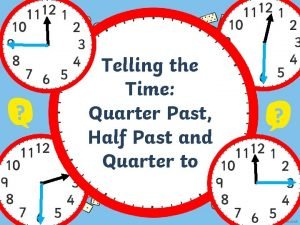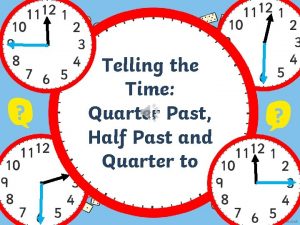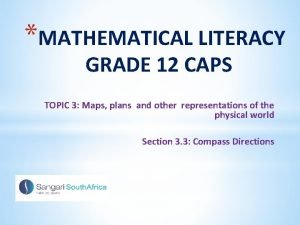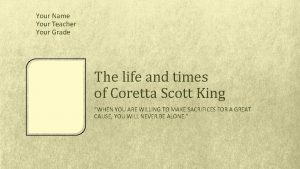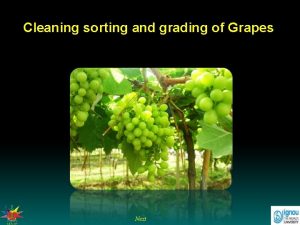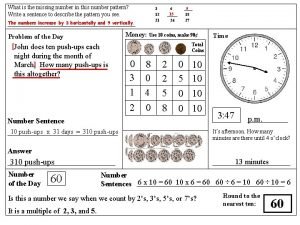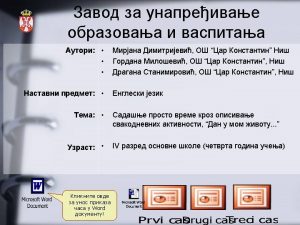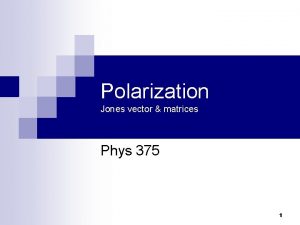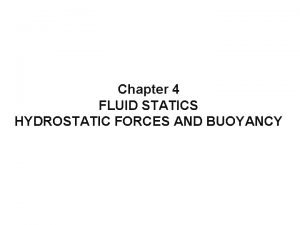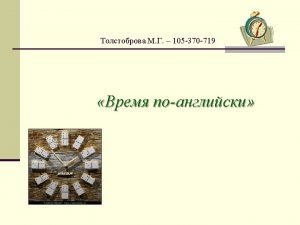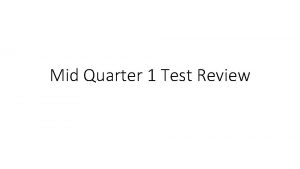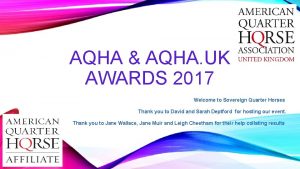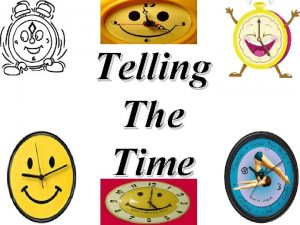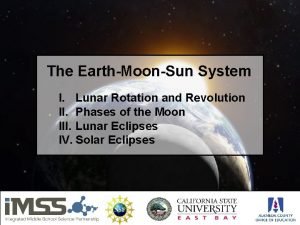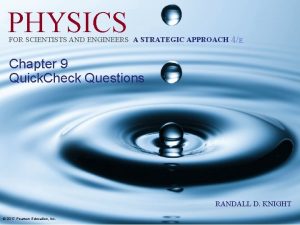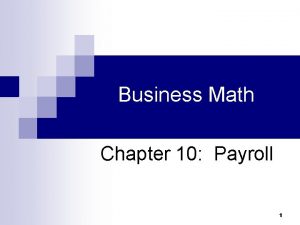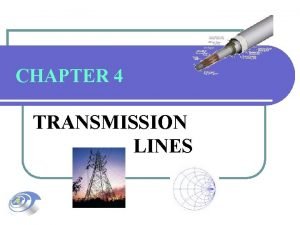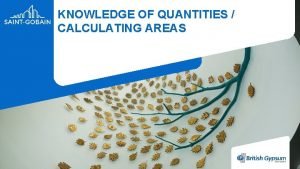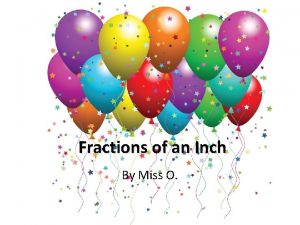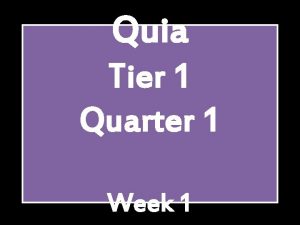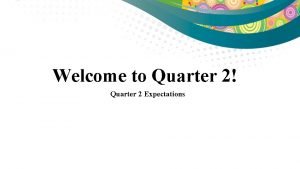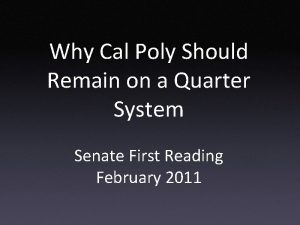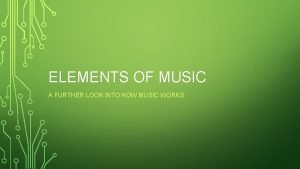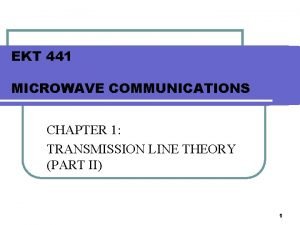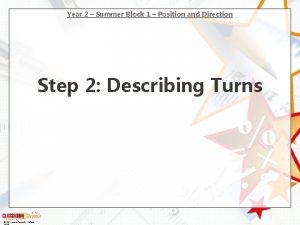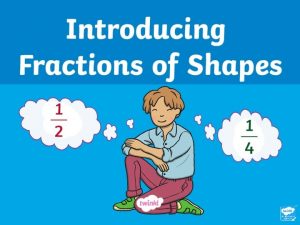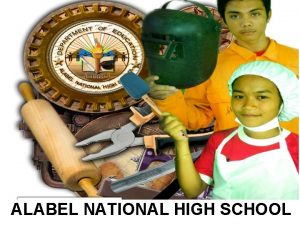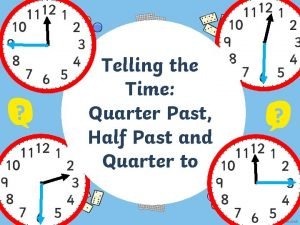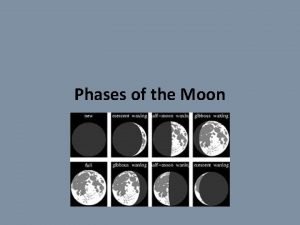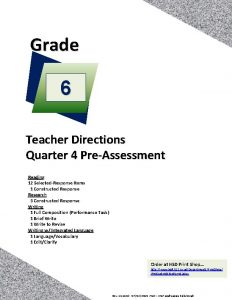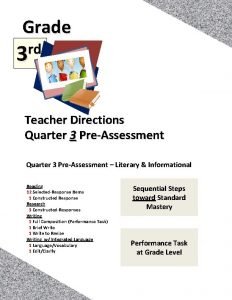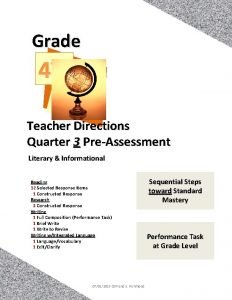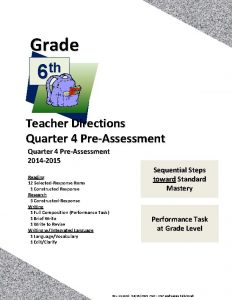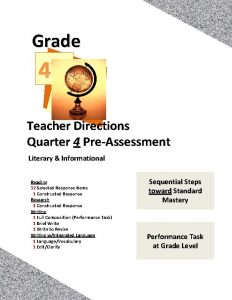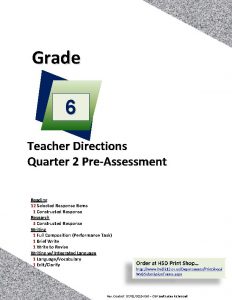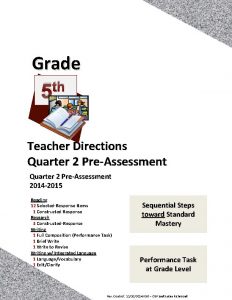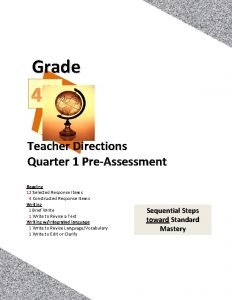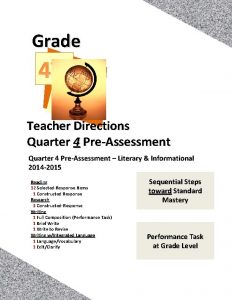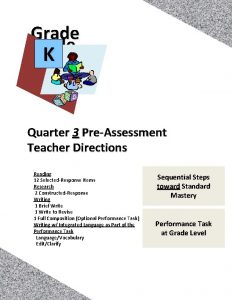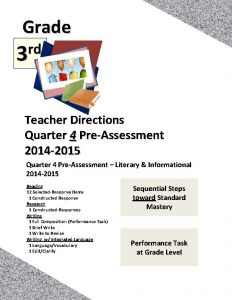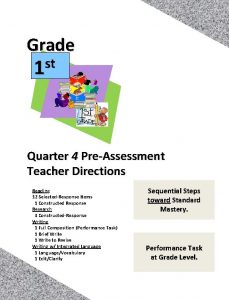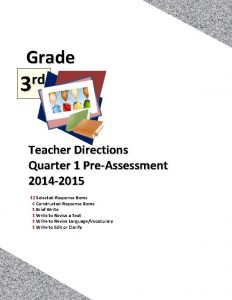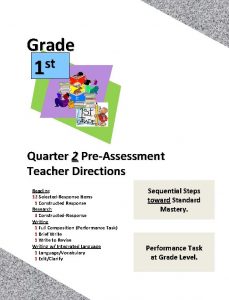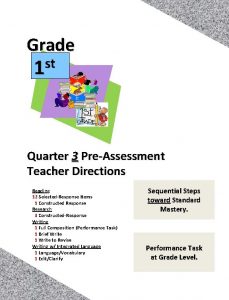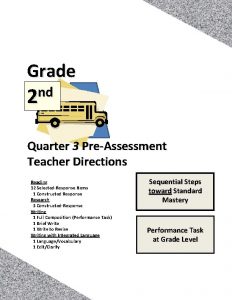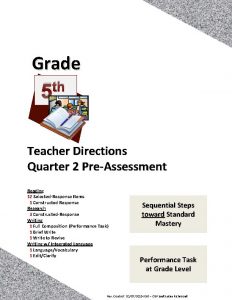Grade nd 2 Quarter 2 PreAssessment Teacher Directions













































- Slides: 45

Grade nd 2 Quarter 2 Pre‐Assessment Teacher Directions Reading 12 Selected‐Response Items 1 Constructed Response Research 3 Constructed‐Response Writing 1 Full Composition (Performance Task) 1 Brief Write 1 Write to Revise Writing Integrated Language 1 Language/Vocabulary 1 Edit/Clarify Sequential Steps toward Standard Mastery Performance Task at Grade Level

nd 2 Quarter Two Pre. Assessment Reading: Literature Targets Standards DOK 4 Reasoning & Evaluation RL. 2. 6 3‐ 4 5 Analysis Within or Across Texts RL. 2. 6, RL. 2. 7 3‐ 4 6 Text Structures/Features RL. 2. 5 2‐ 3 Reading: Informational Targets Standards DOK 4 Reasoning & Evaluation RI. 2. 6 3‐ 4 5 Analysis Within or Across Texts RI. 2. 7 2‐ 3 6 Text Structures/Features Rl. 2. 5, RI. 2. 7 2 Note: There may be more standards per target. The writing standards assessed in this assessment are boxed. Informational Writing and Language Targets Standards DOK 3 a Brief Informational Write W 2. 2 a, W 2. 2 b, W. 2. 2 a, W. 2. 2 b, W 2. 2 c, W. 2. 2 c, and/or W. 2. 9 W 2. 9 3 3 b Write‐Revise Informational W. 2. 2 a, W 2. 2 b, W. . 2. 2 a, W. 2. 2 b, W 2. 2 c W. 2. 2 c and/or W. 2. 9 W 2. 9 2 4 Full Informational Composition W 2. 2 a, W 2. 2 b, W. 2. 2 a, W. 2. 2 b, W 2. 2 c, W 2. 3 b, W. 2. 4, W 2. 5, W 2. 4, W. 2. 5, W 2. 8, W 2. 9 W. 2. 9 4 8 Language‐Vocabulary Use L. 2. 3 a 1‐ 2 9 Edit and Clarify L. 2. 2 a 1‐ 2

All elementary ELA assessments were reviewed and revised in June of 2015 by the following amazing and dedicated HSD K‐ 6 th grade teachers. Deborah Alvarado Lincoln Street Ko Kagawa Minter Bridge Linda Benson West Union Jamie Lentz Mooberry Anne Berg Eastwood Sandra Maines Quatama Aliceson Brandt Eastwood Gina Mc. Lain TOSA Sharon Carlson Minter Bridge Teresa Portinga Patterson Deborah Deplanche Patterson Judy Ramer Consultant Alicia Glasscock Imlay Sara Retzlaff Mc. Kinney Sonja Grabel Patterson Jami Rider Free Orchard Megan Harding Orenco Kelly Rooke Free Orchards Renae Iversen Teacher Mentor Angela Walsh Witch Hazel Ginger Jay Witch Hazel Performance Task Classroom Activities for K – 6 were written by Jamie Lentz, Gina Mc. Lain, Hayley Heider, Anna Wooley, Gretchen Erlandsen, Deborah Deplanche, Connie Briceno, Judy Ramer, Carrie Ellis, Sandra Maines, Renae Iversen, Anne Berg, Aliceson Brandt and Ko Kagawa. Rev. Control: 07/01/2015 HSD – OSP and Susan Richmond 3

Background This is a pre-assessment to measure the task of writing an informational piece. Full compositions are always part of a Performance Task. A complete performance task would have: Part 1 • A Classroom Activity (30 Minutes) (35 minutes – Independent work) • Passages or Stimuli to Read • 3 Research Questions • There may be other constructed response questions. Part 2 • An Informational Composition (70 Minutes) Students should have access to spell-check resources but no grammar-check resources. Students can refer back to their passages, notes and 3 research questions and any other constructed responses, as often they’d like. Directions 30 minutes 1. You may wish to have a 30 minute classroom activity. The purpose of a PT activity is to insure that all students are familiar with the concepts of the topic and know and understand key terms (vocabulary) that are at the upper end of their grade level (words they would not normally know or are unfamiliar to their background or culture). The classroom activity does not pre-teach any of the content that will be assessed! 35 minutes 2. Students read the passages independently. If you have students who can not read the passages you may read them to those students but please make note of the accommodation. Remind students to take notes as they read. During an actual SBAC assessment students are allowed to keep their notes as a reference. 3. Students answer the 3 research questions or other constructed response questions. Students should also refer to their answers when writing their full informational piece. 15 minute break 70 Minutes 4. Students write their full composition (informational piece). Scoring An Informational Rubric is provided. Students receive three scores: 1. Organization and Purpose 2. Evidence and Elaboration 3. Conventions Rev. Control: 07/01/2015 HSD – OSP and Susan Richmond 4

Order at HSD Print Shop… http: //www. hsd. k 12. or. us/Departments/Print. Shop/ Web. Submission. Forms. aspx Directions The HSD Elementary assessments are neither scripted nor timed assessments. They are a tool to inform instructional decision making. It is not the intent of these assessments to have students “guess and check” answers for the sake of finishing an assessment. All students should move toward taking the assessments independently but many will need scaffolding strategies. If students are not reading at grade level and can’t read the text, please read the stories to the students and ask the questions. Allow students to read the parts of the text that they can. Please note the level of differentiation a student needed. About this Assessment This assessment includes: Selected-Response, Constructed-Response, and a Performance Task. Types of SBAC Constructed Response Rubrics in this Assessment http: //www. livebinders. com/play? id=774846 Reading • 2 Point Short Response • 3 Point Extended Response Writing • 4 Point Full Composition Rubric (Performance Task) • 3 Point Brief Write (1 -2 Paragraphs) Rubric • 3 Point Write to Revise Rubrics as Needed Research • 2 Point Rubrics Measuring Research Skill Use Quarter 2 Performance Task The underlined sections are those scored on SBAC. Please take 2 days to complete performance tasks. Part 1 • • Part 2 Classroom Activity if Desired/Needed Read two paired passages. Take notes while reading (note-taking). Answer SR and CR research questions about sources Components of Part 1 Note‐Taking: Students take notes as they read passages to gather information about their sources. Students are allowed to use their notes to later write a full composition (essay). Note-taking strategies should be taught as structured lessons throughout the school year in grades K – 6. A teacher’s note‐taking form with directions and a note‐ taking form for your students to use for this assessment is provided, or you may use whatever formats you’ve had past success with Please have students practice using the note-taking page in this document before the actual assessment if you choose to use it. Research: In Part 1 of a performance task students answer constructed response questions written to measure a student’s ability to use research skills needed to complete a performance task. These CR questions are scored using the SBAC Research Rubrics rather than reading response rubrics. • • • Plan your essay (brainstorming -pre-writing). Write, Revise and Edit (W 2. 5) Writing a Full Composition or Speech Components of Part 2 Planning Students review notes and sources and plan their composition. Write, Revise and Edit Students draft, write, revise and edit their writing. Word processing tools should be available for spell check (but no grammar check). Full Written Informational Composition • introduction (identifies the topic and provides a focus) • organization (definition, classification, comparison/contrast, etc. ), • development (with facts, concrete details, quotations, other information) • transitions (linking ideas) • precise language and domain‐specific vocabulary • conclusion (closure) • Conventions of Standard English. There are NO Technology‐enhanced Items/Tasks (TE) Note: It is highly recommended that students have experiences with the following types of tasks from various on‐line instructional practice sites, as they are not on the HSD Elementary Assessments: reordering text, selecting and changing text, selecting text, and selecting from drop-down menu Rev. Control: 07/01/2015 HSD – OSP and Susan Richmond 5

Plant and Animal Relationships Performance Task Classroom Activity This classroom pre-activity follows the Smarter Balanced Assessment Consortium general design of contextual elements, resources, learning goals, key terms and purpose [http: //oaksportal. org/resources/] The Classroom Activity was written Gretchen Erlandsen and Anna Wooley. The Classroom Activity introduces students to the context of a performance task, so they are not disadvantaged in demonstrating the skills the task intends to assess. Contextual elements include: 1. an understanding of the setting or situation in which the task is placed 2. potentially unfamiliar concepts that are associated with the scenario 3. key terms or vocabulary students will need to understand in order to meaningfully engage with and complete the performance task The Classroom Activity is also intended to generate student interest in further exploration of the key idea(s). The Classroom Activity should be easy to implement with clear instructions. Please read through the entire Classroom Activity before beginning the activity with students to ensure any classroom preparation can be completed in advance. Throughout the activity, it is permissible to pause and ask students if they have any questions. Resources needed: Cherry life cycle video: https: //www. youtube. com/watch? v=Q 80 pc. N 0 lp 8 s Cycle poster prepared for lesson Markers Learning Goals: Students will understand that plants and animals can have a symbiotic relationship. Students will understand that plants are different throughout different seasons. Students will understand the key terms: Note: Definitions are provided here for the convenience of facilitators. Students are expected to understand these key terms in the context of the task, not memorize the definitions. cycles (plant and animal life cycles, seasons) preparing for changes (adaptations, storing food or water, growing thicker fur/shedding fur) Purpose: The facilitator’s goal is to give students a better understanding of various cycles (seasons, plant/animal life cycles), as well as how animals prepare for different seasons, specifically winter. *Facilitators can decide whether they want to display ancillary materials using an overhead projector or computer/Smartboard, or whether they want to produce them as a handout for students.

Plant and Animal Relationships continued… You went on a field trip to the park. Your teacher has asked you to write an article describing what plants look like in the different stages of its life cycle. The Plant Life Cycle Illustration can help you. Explain how the different stages of a plant's life cycle affect a squirrel's ability to gather food. Facilitator says: “Today we will get ready for the Plants and Animals Performance Task. We will talk about how plants change as they grow. Then we will talk about why this is important to animals. “Turn and talk to you partner about how plants change as they grow. ” Discussion question: “What do you know about how plants change as they grow? ” Possible student responses (unscripted) “Plants start little and get big. ” “Plants grow from seeds. ” “Some plants grow into big trees. ” [Give students 2 minutes to turn and share with a partner] Facilitator says: “Students, please help me to make a chart of the life cycle of a tree. ” [The facilitator will solicit responses from students to label the stages of a tree’s development (seed, sprout, young tree, adult tree)] Facilitator says: “Turn and talk to your partner about why plants are important to animals. ” Discussion question: “What do you know about why plants are important to animals? ” Possible student response (unscripted) “Animals eat plants. ” “Animals need plants to hide under. ” “Animals need plants for food. ” Facilitator says: “Now we are going to watch a short video about plants and animals. ” https: //www. youtube. com/watch? v=Q 80 pc. N 0 lp 8 s

Plant and Animal Relationships continued… During this video, the facilitator will pause during the sections that include text. They should label a cherry tree cycle poster with pictures of the tree and include labels of the stages in the cherry tree development for spring and summer. When there is a text in the video, the teacher should add to the poster the corresponding labels for spring (flowers, bees come to pollinate) and for summer (cherries mature, cherries are picked by people and animals). The video only informs through spring and summer, therefore, discussion will then follow later in the lesson guiding students to finish the cycle for fall and winter. Facilitator says: “Did you notice that this is another cycle for adult trees? It goes through different stages depending on the season. ” [Facilitator will then continue guiding students in labeling the various parts of the life cycle of a tree through the seasons, helping students to infer what happens in the fall and the winter. ] Facilitator says: “What do we know about the changes that happen with trees during the fall? ” [Turn and talk, share out responses] Possible student responses (unscripted) “The leaves change color. ” “The leaves fall off the trees. ” “All of the fruit is gone. ” [Facilitator posts the fall picture to the cycle and labels this section with student responses. ] Facilitator says: “What do we know about the changes that happen with trees during the winter? ” [Turn and talk, share responses] Possible student responses (unscripted) “There are no leaves or fruit on the tree. ” “It’s too cold for the leaves to survive. ” “The tree is just a trunk and branches. ” [Facilitator posts the winter picture to the cycle and labels this section with student responses. ] Discussion question from video: “What did you notice was the relationship between the cherry blossom and the bee? ” Possible student responses (unscripted) “The bee ate the pollen. ” “The tree gave the bee food. ” “The bee moved from tree to tree. ”

Plant and Animal Relationships continued… Facilitator says: “Remember that bees are pollinators. This means that they move pollen from tree to tree while they eat, helping to create new flowers. ” Discussion question: What would happen to the bees if the plant was just a sprout, or a baby plant that has not grown fruit or seeds yet? Possible student responses: The animal dies. They find food somewhere else. Migration. They decide to adapt and eat a different part of the food chain. Facilitator says: “In your performance task, you will be learning more about plant and animal relationships. The group work you did today should help prepare you for the research and writing you will be doing in the performance task. ” Note: Facilitator should collect student notes from this activity.

spring winter fall summer ancillary materials Rev. Control: 07/01/2015 HSD – OSP and Susan Richmond 10

ancillary materials Bee and Cherry Blossom Video https: //www. youtube. com/watch? v=Q 80 pc. N 0 lp 8 s Poster prepared for lesson Poster with spring/summer cherry blossom section completed after video Poster after life cycle done with students Poster completed after inference of fall and winter… blank boxes are where the pictures of the trees through the seasons would go Rev. Control: 07/01/2015 HSD – OSP and Susan Richmond 11

Teachers: This is a note‐taking page students can use when researching about a topic. Instruct student to read a multi‐paragraph text. Name___________ What is the main topic of the text? 1 Ask, “What is this text mostly about? ” Tell them this is the main topic of the text. Have students share how they know what the text is mostly about. Ask students to write the main topic of the text. Note: topic means the entirety of the text which can be told in one word or phrase. Which key details help you know the specific focus of paragraph ____? Explain, “a specific focus is what the paragraph is telling about the topic Key details help us find the specific focus of paragraphs. ” Example: If the main topic is DOGS, Some key details in one paragraph could be. . 2 • the dog likes to play fetch. • the dog likes to play withyou the ball. Which key details help know the specific focus of paragraph ____? The specific focus of this paragraph could be things that dogs like to do or that dogs are playful Students should be able to identify the specific focus in two or more paragraphs of the text. Remember students will need to have a note‐taking form for each text. This form is for informational texts. You can also use a graphic organizer of your choice that emphasizes the standard vocabulary: Main Topic (RI. 2. 2) Key Details (RI. 2. 1) Specific Focus (RI. 2. 2)

Note‐Taking Name___________ What is the main topic of the text? Which key details help you know the specific focus of paragraph ____?

Determining Grade Level Text Grade level text is determined by using a combination of both the CCSS new quantitative ranges and qualitative measures. Example: If the grade equivalent for a text is 6. 8 and has a lexile of 970, quantitative data shows that placement should be between grades 4 and 8. Common Core Band Flesch‐Kincaid® The Lexile Framework® 2 nd ‐ 3 rd 1. 98 ‐ 5. 34 420 ‐ 820 4 th ‐ 5 rd 4. 51 ‐ 7. 73 740 ‐ 1010 6 th – 8 th 6. 51 ‐ 10. 34 925 ‐ 1185 9 th – 10 th 8. 32 ‐ 12. 12 10. 50 ‐ 1335 11 th ‐ CCR 10. 34 ‐ 14. 20 11. 85 ‐ 1385 Four qualitative measures can be looked at from the lower grade band of grade 4 to the higher grade band of grade 8 to determine a grade level readability. Rate your text from easiest to most difficult between bands. 4 Qualitative Factors Beginning of lower (band) grade End of lower (band) grade Beginning of higher (band) to mid End of higher (band) grade Not suited to band Purpose/Meaning Structure Language Clarity Language Overall Placement The combination of the quantitative ranges and qualitative measures for this particular text shows that grade 6 would be the best readability level for this text. To see more details about each of the qualitative measures please go to slide 6 of: http: //www. corestandards. org/assets/Appendix_A. pdf Rev. Control: 07/01/2015 HSD – OSP and Susan Richmond 14

Grades K ‐ 2: Generic 4‐Point Informational/Explanatory Writing Rubric Score Statement of Purpose/Focus and Organization Statement of Purpose/Focus Uses a combination of drawing, dictation, & writing (K) to compose Explains something more about the topic OR a connection is made between topic & broader Exemplary idea(s) Clearly presents the topic and focus/controlling idea 4 3 Proficient Uses a combination of drawing, dictation, & writing (K) to compose Topic (context) and focus/controlling idea are clearly stated (gr K-3) Uses a combination of drawing, dictation, & writing (K) to compose Has topic and attempts a focus/information, but focus may shift or not Developing be relevant to the topic chosen 2 Uses a combination of drawing, dictation, & writing (K) to compose Attempts to identify a topic but lacks a focus or may have more than Merging one topic or confusing topic as stated 1 0 Development: Language and Elaboration of Evidence Organization Language and Vocabulary Conventions Intro, body, and conclusion support focus Uses several transitions appropriately (e. g. , because, since, and, but, also, for example, since) to connect or group ideas Has a depth of information; Maintains voice/tone of insightful knowledgeable person Elaborates using a variety conveying information of relevant details, – knows when to use definitions, examples, formal-informal quotes, text evidence to language support focus/concepts Uses effective, precise vocabulary and variety of sentence structures Edits with support /resources Has few or no errors in grammar, word usage, or mechanics as appropriate to grade Has overall coherence (K-3); Provides a concluding statement or section (gr, 1, 2, 3) Groups related ideas (gr 3) that support the focus Uses transitions to connect ideas (gr 3) Some authentic details, definitions, facts, text evidence support focus Adds labels or captions to illustration, drawing, visuals, charts/tables, or diagram to enhance details, facts, and ideas Produces complete simple (K), compound (g, 1 - 3), complex (gr 3) sentences Appropriate use of vocabulary (nouns, plurals, verbs, pronouns, adjectives, adverb, content-specific) Uses adult/peer feedback to Revise Edits with support /resources (gr 2 -3) Minor errors do not interfere with reader understanding (e. g. , capitalization, punctuation; spelling) Introduction, body, and conclusion are evident, but may lack clarity or Coherence (e. g. , attempts to connect ideas, but may not be logical or make sense) Some elaboration strategies are evident in drawings or writing (gr K-3), or with support/ questioning from peers or adults (gr K -1) Ideas may not be fully elaborated or details may be insufficient to support topic Vocabulary use has minor errors Dictates, writes, and expands simple complete sentences Uses adult/peer feedback to revise Edits with support from peers or adults (gr 2 -3) Uses grade-appropriate basic mechanics and word use with some errors Attempts introduction, body, and conclusion, but one or more parts are missing No details provided or attempts to add details to drawings or writing which may be random, inaccurate, or irrelevant Generally uses basic, incorrect, or below grade level vocabulary when dictating (K) or writing Uses adult/peer feedback to revise Edits with support from peers or adults (gr 2 -3) Uses below grade-level basic mechanics with frequent errors A response gets no credit if it provides no evidence of the ability to [fill in with key language from the intended target]. Working Drafts of ELA rubrics for assessing CCSS writing standards ‐‐‐ © (2010) Karin Hess, National Center for Assessment [khess@nciea. org Rev. Control: 10/25/2014 HSD – OSP and Susan Richmond 15

Pre‐Assessment and Learning Progressions The pre‐assessments are very unique. They measure progress toward a standard Unlike the Common Formative Assessments which measure standard mastery, the pre-assessments are more like a base-line picture of a student’s strengths and gaps, measuring skills and concepts, students need “along the way, ” in order to achieve standard mastery. END of Beg. of QTR CFA Example of a Learning Progression for RL. 2. 1 Pre-Assessments Measure Adjustment Points (in purple) RL. 2. 1 grade ‐level standard assessment. After the pre-assessment is given, Learning Progressions provide informal formative assessment below and near grade-level “tasks” throughout each. Throughout quarter. DOK 1 ‐ Ka Recall who, what, where, when, why and how about a story read and discussed in class. DOK ‐ Kc Use and define Standard Academic Language: who, what, where, when, why, and how; ask, answer, questions, key details DOK 1 ‐ Cd Connect the terms who to characters; where and when to setting; what and how to sequence of events. DOK 1 ‐ Cf Ask and answer who, what, where, when, why and how questions about key details in a text. the QTR DOK 2 ‐ Ch Concept Development Student understands that key details help tell who, what, where, when, why and how. DOK 2 ‐ Ck Uses key details to identify who, what, where, when, why and how about a story not read in class. QTR DOK 2 ‐Cl Finds information using key details to answer specific questions about a new story. Standard Mastery RL. 2. 1 Ask and answer such questions as who, what, where, when, why, and how to demonstrate understanding of key details in a text So what about a post-assessment? There is not a standardized post-assessment. The true measure of how students are doing along the way, is assessed in the classroom during instruction and classroom formative assessment. For this reason The CFA’s are not called post-assessments. The CFAs measure the end goal, or standard mastery. However, without the pre-assessments, how will we know what our instruction should focus on throughout each quarter? Learning Progressions: are the predicted set of skills needed to be able to complete the required task demand of each standard. The learning progressions were aligned to Hess’ Cognitive Rigor Matrix. The pre-assessments measure student proficiency indicated on the boxes in purple (adjustment points). These points are tasks that allow us to adjust instruction based on performance. For instance, if a student has difficulty on the first purple adjustment point (DOK-1, Cf) the teacher will need to go back to the tasks prior to DOK-1 Cf and scaffold instruction to close the gap, continually moving forward to the end of the learning progression. There is a Reading Learning Progression checklist for each standard in each grade that can be used to monitor progress. It is available at: http: //sresource. homestead. com/Grade-2. html Rev. Control: 07/01/2015 HSD – OSP and Susan Richmond 16

Quarter Two Reading Literature Learning Progressions. The indicated boxes highlighted before the standard, are assessed on this preassessment. The standard itself is assessed on the Common Formative Assessment (CFA) at the end of each quarter. DOK 1 ‐ Ka Retell specific details about beginning and ending events in a story read and discussed in class. DOK 1 ‐ Kc Define and understand Standard Academic Language: overall, structure, include, describe, beginning, introduce, ending, action and concludes. DOK 1 ‐ Cd Describe what happened at the beginning and ending of a story read and discussed in class. DOK 1 ‐ Cf Answer who, what, when where or how questions about the beginning and ending of a story read but not discussed in class. Not Assessed DOK 2 ‐ Ch Concept Development Understands that the action (event) beginning of a story changes story is an throughout the introduction of story. Gives character, examples of how setting and an the ending event. concludes the SELECTED action. RESPONSE Ka Kc Cd Cf Ch Cj DOK 2 Cl Retells facts or details about characters from a text read and discussed in class. Define and understand Standard Academic Language: differences, points of view, characters, speaking, including, voice (sounds like), dialogue and aloud. Identifies characters, setting and events in a story read and discussed in class. Answers who, what, when, where and how questions about what specific characters said in a dialogue (read/discus sed text). Understan ds that different characters may have different points of view. Gives an example. Infers what a character may think or feel based on textual evidence. SELECTED RESPONSE Locate actual character dialogue to support an observatio n of what a character may think of feel. DOK 2 ‐ Cl Locates information to support how the that beginning contributes to introduces a story the and the ending development concludes the of the action of a new text. SELECTED RESPONSE DOK 2 ‐ ANt Compare Identify differences characteris in points of tic text view features between that characters in represent a new text. dialogue SELECTED (quotation RESPONSE marks, play scripts, etc. ). DOK 2 ‐ ANp Standard RL. 2. 5 Describe the overall structure of a story, including describing how the beginning introduces the story and the ending concludes the action DOK 3 ‐ APx Standard Recognizes different points of views of different characters by their text dialogue. CONSTRUCTED RESPONSE RL. 2. 6 Acknowledge differences in the points of view of characters, including by speaking in a different voice for each character when reading dialogue aloud. DOK 1 ‐ Ka DOK 1 ‐ Kc DOK 1 ‐ Cd DOK 1 ‐ Cf DOK 2 ‐ Ch DOK 2 ‐ Cj DOK 2 ‐ Cl DOK 2 ‐ APn Standard Recognizes illustrations or words in print that represent characters, setting (read and discussed in class). Define and understand Standard Academic Language: information, illustration and illustrator, print, text, digital, character, setting and plot. Describes characters and setting referring to illustrations and words from a print or digital text. Answers who, what, when, where, why and how questions about the plot of a story read and discussed in class. SELECTED RESPONSE Concept Development Understands that illustrations and print provide information about characters, setting or plot. Make inferences and logical predications from illustrations and text about character, setting or plot in a new text. Use information gained from the illustrations and words in a print or digital text to answer questions about a central idea (plot). SELECTED RESPONSE Obtain and interpret information using text features (illustrations, texts, digital texts) for a specific purpose or assignment (new text). CONSTRUCTED RESPONSE RL. 2. 7 Use information gained from the illustrations and words in a print or digital text to demonstrate understanding of its characters, setting, or plot. Rev. Control: 07/01/2015 HSD – OSP and Susan Richmond 17

Quarter Two Reading Informational Learning Progressions. The indicated boxes highlighted before the standard, are assessed on this preassessment. The standard itself is assessed on the Common Formative Assessment (CFA) at the end of each quarter. DOK 1 ‐ Ka DOK 1 ‐ Kc Recalls or recognizes key facts or information in a text with various text features (read and discussed in class). DOK 1 ‐ Ce Define and understand Standard Academic Language: captions, headings, subheadings, bold print, glossaries, indexes, table of contents, electronic menus, icons, locate efficient, key facts and text features. DOK 1 ‐ Ka DOK 1 ‐ Kc DOK 1 ‐ Cf Retells parts of a text that answer, explain or describe specific information about a topic (read and discussed in class). Define and understand Standard Academic Language: main purpose, author’s purpose, answer, explains and describe. Uses correct text feature words when referring (e. g. , captions, bold print, subheadings, glossaries, indexes, electronic menus or icons). DOK 2 ‐ Ch DOK 1 ‐ Cf DOK 2 ‐ Ch Answer who, what, Concept Locates text features to RI. 2. 5 Know and use various when, where or how Development provide sufficient text features (e. g. , captions, questions about key Understands evidence for a purpose bold print, subheadings, facts or information in that text (to support a conclusion, glossaries, indexes, electronic a text using text features are a answer a question, menus, icons) to locate key features as evidence source to locate etc…). facts or information in a text (new text read but information SELECTED RESPONSE efficiently. not discussed in class). efficiently. SELECTED RESPONSE DOK 2 ‐ Ck DOK 2 ‐ Cl Answer who, Concept Identify main Locate what, when, Development ideas or makes information where or how Understands accurate to support a questions that authors generalization purpose that answer, write text to s about a topic (answer a explain or answer, based on question, describe explain or author’s explain or (read and describe evidence. describe) in a discussed in information. new text. class). SELECTED RESPONSE DOK 1 ‐ Ka DOK 1 ‐ c Recall or recognize specific images in a visual representation from a text read and discussed in class. Define and understand Standard Academic Language: Specific, explain, images, (e. g. diagram, chart, etc. . ), contributes and clarify. DOK 1 ‐ Ce DOK – 2 APn Standard DOK 2 ‐ Cl DOK 1 ‐ Cf Uses correct Answers words when questions that referring to visual require images referring to (diagrams, charts, visual images tables, etc. . . ). in a new text). SELECTED RESPONSE DOK 2 ‐ ANp DOK 3 ‐ Cu DOK 3 ‐ Cv Categorize Connects facts in a ideas (more text that the than one) author within a text explain, that explain describes or or answer a answers on question. a graphic organizer. Identify the main purpose of a text, including what the author wants to answer, explain, or describe. DOK 2 ‐ Ch Concept Development Understands that visual images can help contribute or clarify a text. DOK 2 ‐ Cl DOK 3 ‐ APx Standard Identifies a main RI. 2. 6 Identify the purpose in a new main purpose of a text (not read or text, including what discussed in the author wants to class) using answer, explain, or specific describe. statements about what the author wants to answer, explain or describe. CONSTRUCTED RESPONSE DOK 2 ‐ APn Standard Locate the accurate Interpret RI. 2. 7 Explain how visual representations information from a specific images (e. g. , that contribute to and visual representation a diagram showing clarify a text. in order to answer how a machine SELECTED RESPONSE clarifying questions works) contribute to about a text. and clarify a text. CONSTRUCTED RESPONSE Rev. Control: 07/01/2015 HSD – OSP and Susan Richmond 18

A note about constructed responses: Constructed response answers are not written “in stone. ” There is no perfect way a student should respond. Look for the general intent of the prompt and student response and follow the rubric below as much as possible. Use your best judgment. Unlike DOK-1 questions where there is one right and wrong answer, constructed responses are more difficult to assess. Overall consistency of intent based on most of your student responses can guide you. Quarter 2 Pre‐Assessment Research Constructed Response Answer Key Constructed Response Research Rubrics Target 4: ability to cite evidence to support opinions and/or ideas Standard RL. 2. 6: Constructed Response Research Rubric Question #7 Prompt: How does the author show you Chestnut and Daisy’s point of view? Use details, dialogue and examples from the passage to support your answer. Teacher /Rubric Language Response The response cites evidence of knowing what language shows point of view. This will include the fact that the author uses the phrases, “said Daisy. ” and “said Chestnut” as well as the use of the pronouns he and she. The response supports the idea of text dialogue pointing out the type of point of view based on the language used. The student will point out that all the dialogue used points back to Daisy and Chestnut having a conversation with each other. Student Language Response Example 2 1 0 The student response states the idea that the text dialogue shows us Chestnut and Daisy are having a conversation because the author uses words like he, she, Daisy said, and Chestnut said. The student cites evidence to confirm the story is told from Daisy and Chestnut’s points of view by giving examples of their conversation from the passage. The author shows us Chestnut and Daisy's point of view by the words he uses. When Chestnut is talking the author uses the word he to show that it is Chestnut talking. He also says, "said Chestnut". This means Chestnut is talking, so it is his point of view. Here is a sentence from the story that shows this: "Then he buried them all over the park. " This was talking about Chestnut. The student response states the idea that Chestnut and Daisy are having a conversation by stating some of the author’s words like he, she, Daisy said, and Chestnut said. The student does not cite evidence by showing conversations they had. The author shows us Chestnut and Daisy's point of view by the words he uses. When Chestnut is talking the author uses the word he to show that it is Chestnut stalking. The response does not state a specific idea or cite evidence enough to answer the prompt. I don’t think squirrels can really talk. Toward RL. 2. 6 DOK 3 ‐ APx Recognizes different points of views of different characters by their text dialogue. Rev. Control: 07/01/2015 HSD – OSP and Susan Richmond 19

A note about constructed responses: Constructed response answers are not written “in stone. ” There is no perfect way a student should respond. Look for the general intent of the prompt and student response and follow the rubric below as much as possible. Use your best judgment. Unlike DOK-1 questions where there is one right and wrong answer, constructed responses are more difficult to assess. Overall consistency of intent based on most of your student responses can guide you. Quarter 2 Pre‐Assessment Research Constructed Response Answer Key Research Constructed Response Rubrics Target 2: Locate, Select, Interpret and Integrate Information. Standard RL. 2. 6: Research Constructed Response Rubric Question #8 Prompt: What are some things squirrels do? Use details and examples from the passage and illustrations in Oh Nuts! Teacher/Rubric Language Response The response gives sufficient evidence of the ability to locate and select information. Included should be all the activities that squirrels engage in. This could include that they raced on top of the fence, climbed to the tops of the trees, took naps under the raspberry bushes, and ate food left behind by people. Additionally, information should be included about squirrels hunting for nuts. From the illustrations students should include how the nuts are stored for the winter when they need food. The response gives sufficient evidence of the ability to interpret and integrate information to a cohesive response. Included should be that squirrels are clever because they know the best way to get food, find shortcuts, and provide food for themselves all winter. Also included would be that squirrels help the environment because many of the nuts that they bury grow up into trees. Student Language Response Example 2 Student locates and selects information about the activities that squirrels do and integrates that information into a response. Squirrels can do many things. They can play on fences and climb up and down trees. Squirrels in the park eat left over food people leave. When a squirrel buries a nut it can grow into a tree. This helps trees grow! They are pretty clever too. They can find food anywhere! Student locates and selects some information about the activities that squirrels do and may integrate that information into 1 0 a response. Squirrels can do many things. They play and climb. They bury nuts that can provide them with food later. They are clever. The student does not give enough evidence of the ability to locate, select, interpret and integrate information about what squirrels do. Squirrels are animals that live in trees. They eat nuts. Toward RL. 2. 7 DOK 2 ‐ APn Obtain and interpret information using text features (illustrations, texts, digital texts) for a specific purpose or assignment. Rev. Control: 07/01/2015 HSD – OSP and Susan Richmond 20

A note about constructed responses: Constructed response answers are not written “in stone. ” There is no perfect way a student should respond. Look for the general intent of the prompt and student response and follow the rubric below as much as possible. Use your best judgment. Unlike DOK-1 questions where there is one right and wrong answer, constructed responses are more difficult to assess. Overall consistency of intent based on most of your student responses can guide you. RI. 2. 6 Quarter 2 Pre‐Assessment Reading Constructed Response Rubric Question #15 Prompt: Why did the author write the text, Plant Life Cycles? Use details and examples from the text to support your answer. Teacher Language and Scoring Notes: Sufficient Evidence (conclusion idea) includes a conclusion statement that plants go through a life cycle that ends with a new plant beginning. Specific identifications from the text could include the different parts to the cycle (starts as a seed, water and sun help it grow, seed sprouts and grows leaves and a stem, flowers grow into fruit, the fruit has seeds, and new plants are started from the seeds). Full Support from the text include other relevant details or examples from the text that support the fact that a cycle is something that repeats itself. The student gives a proficient response by providing evidence of what the special focus was of the text Plant Life Cycles. Included should be all of the steps of a plant’s life cycle listed above. Additionally, the student needs to add the point that the life cycle is something that repeats itself because of the seeds the fruit produces. 3 2 1 0 The author wrote the text Plant Life Cycles to tell us that plants have a life cycle. In the text, it told us about the different parts to the cycle, like starting with a seed, then sprouting and growing leaves and a stem, then flowers growing where the seeds are, and how those seeds turn into a new plant. Then the cycle can start all over again. The student gives a partial response by providing some evidence of the life cycle. Additionally, the student mentions it’s a cycle but might not connect that the seed starts things again. The author wrote this text to tell us that plants have a cycle. It starts with a seed, then a plant, then flowers and more seeds. Then they start over with the seed. The student gives a minimal response about the life cycle parts and does not point out the fact that the seed starts the cycle over again. The author wrote this to tell us about plants and their life cycle. The student provides no evidence about why the author wrote this text. . Plants are important to this world. Toward RI. 2. 6 DOK‐ 3 APx Identifies a main purpose in a new text using specific statements about what the author wants to answer, explain or describe. Rev. Control: 07/01/2015 HSD – OSP and Susan Richmond 21

A note about constructed responses: Constructed response answers are not written “in stone. ” There is no perfect way a student should respond. Look for the general intent of the prompt and student response and follow the rubric below as much as possible. Use your best judgment. Unlike DOK-1 questions where there is one right and wrong answer, constructed responses are more difficult to assess. Overall consistency of intent based on most of your student responses can guide you. Quarter 2 Pre‐Assessment Research Constructed Response Answer Key Constructed Response Research Rubrics Target 3: evidence of the ability to distinguish relevant from irrelevant information such as fact from opinion Standard RI. 2. 7: Research Constructed Response Rubric Question #16 Prompt: Explain what happens first, next, then and last in the life cycle of a plant. Teacher/Rubric Language Response The response distinguishes which evidence is relevant about the parts of the life cycle of a plant, and the fact that at the end it starts all over. It should include that (1)first the plant starts as a seed, (2)next water and sun help it grow, (3) then the seed sprouts and, (4) with more sun and water, the plant grows leaves and a stem, (5) then the flowers grow into fruit and the fruit has seeds, and (6) last the new plants are started from the seeds starting the cycle all over. Student Language Response Example 2 1 0 The student is able to distinguish evidence that is relevant about the parts of the life cycle of a plant and put them in the correct order. They also need to include that at the end the cycle starts all over again. There are several parts to a plant life cycle. First the plant starts as a seed, next water and sun help it grow, then the seed sprouts and the plant grows leaves and a stem, then the flowers grow into fruit and the fruit has seeds, and last the new plants are started from the seeds starting the cycle all over. The student is able to distinguish some evidence that is relevant about a plant’s life cycle. They might not include the fact that the cycle starts all over again. First the plant starts as a seed, then the plant grows leaves and a stem, then the flowers grow into fruit and the fruit has seeds. The student is not able to distinguish relevant from irrelevant information about a plant’s life cycle. Water makes plants grow. Toward RI. 2. 7 DOK‐ 2 APn Interpret information from a visual representation in order to answer clarifying questions about a text. Rev. Control: 07/01/2015 HSD – OSP and Susan Richmond 22

Note: “Brief Writes” should take no longer than 10 minutes. Brief writes are scored with a 2 -3 point rubric. Full compositions are scored with a 4 point rubric. The difference between this rubric and the constructed response reading rubrics, is that the Brief Write Rubric is assessing writing proficiency in a specific area, while the reading rubrics are assessing comprehension. Quarter 2 Pre‐Assessment Brief Write Constructed Response Answer Key Organization: Conclusion Standard W. 2. 2. c : Provide a concluding statement or section related to the information or explanation presented. Target 3 a Question # 17 : Write one or two more sentences to conclude the paragraph. Use details from the passage, Plant Life Cycles. Prompt: A student is writing a paragraph for the class about how a plant’s life cycle begins. Read the paragraph. New Life Cycles Squirrels can help plants begin a new life cycle. Squirrels bury nuts. Sometimes they forget where they bury them. Then the nut might become a seed that starts a new plant. Anytime a seed begins to grow it is the beginning of a new life cycle. When the seed grows you can tell what kind of plant it will be. Teacher /Rubric Language Response Teacher Language and Scoring Notes: The student response should provide a conclusion (1 -2 sentences) that logically follow and support the preceding information about plant life cycles. The conclusion should have a statement that provides an answer to why the preceding information is important, doing more than restating reasons (formulaic ending) or just summarizing main ideas. Student Language Response Example 2 1 0 The response provides a conclusion that follows logically from the preceding information. Sometimes the new plant is a tree. If the new plant is a tree it may someday give squirrels more nuts to eat. The response provides a conclusion that is partially related to the preceding information about but the student restates the conclusion with a “formulaic ending. ” So squirrels help trees grow. This is my conclusion. The response provides no conclusion that is related to the information and may restate random details from the preceding information. Squirrels like to eat nuts too. Rev. Control: 07/01/2015 HSD – OSP and Susan Richmond 23

Listening & reading Productive modalities*: Ways in which students communicate to others (e. g. , speaking, writing, and drawing). Instruction and assessment of productive modalities focus on students’ communication of their own understanding or Speaking & Writing interpretation. Interactive modalities*: Collaborative use of receptive and productive modalities as “students engage in conversations, provide and obtain information, express feelings and emotions, and exchange opinions” (Phillips, 2008, p. 3). Standard 4 Productive (S & W) An ELL can… Listening, speaking, reading, and writing 10 ‐ make accurate use of standard English to communicate in grade-appropriate speech and writing Receptive modalities*: Ways in which students receive communications from others (e. g. , listening, reading, viewing). Instruction and assessment of receptive modalities focus on students’ communication of their understanding of the meaning of communications from others. 9 ‐ create clear and coherent grade‐appropriate speech and text ELP 2 nd – 3 rd Grade Band Standards Organized by Modality 1 construct meaning from oral presentations and literary and informational text through grade-appropriate listening, reading, and viewing 8 determine the meaning of words and phrases in oral presentations and literary and informational text 3 speak and write about grade-appropriate complex literary and informational texts and topics 4 construct grade‐appropriate oral and written claims and support them with reasoning and evidence 7 adapt language choices to purpose, task, and audience when speaking and writing 2 participate in grade‐appropriate oral and written exchanges of information, ideas, and analyses, responding to peer, audience, or reader comments and questions 5 conduct research and evaluate and communicate findings to answer questions or solve problems 6 analyze and critique the arguments of others orally and in writing By the end of an English language proficiency level, an ELL in 2 nd – 3 rd Grade can. . . 1 …construct grade‐ …express an appropriate oral opinion about a and written claims familiar topic. and support them with reasoning and evidence. 2 3 4 …express an opinion about a familiar topic or story, giving one or more reasons for the opinion. …express opinions about a variety of topics, introducing the topic & giving several reasons for the opinion. 5 …express opinions about a variety of topics, introducing the topic, giving several reasons for the opinion, & providing a concluding statement. This performance task is based on writing. As an option if you’d like to monitor growth for ELP as a second goal, teachers can choose to assess ELP standard 4 because it aligns with this specific performance task. Your student’s full composition can be analyzed to identify English language proficiency levels. It is evident that students will be navigating through the modalities to get to the end product. However, it is important to keep in mind what the full opinion writing performance task is assessing and how deeply the student understands class content and language. The ELP growth goal is to provide the “just-right scaffolds” for students to demonstrate their understanding in order for them to move from one proficiency level to the next. Oregon ELP Standards Aligned with Performance Task, 2014; Arcema Tovar

Informational Writing Pre‐Assessment Student and Class Scoring: Scoring Key: Total # Correct 1 = Emerging 0 -4 2 = Developing 3 = Proficient 4 = Exemplary 5 -7 8 - 10 School Year: Grade: Teachers Name: School: 11 - 12 Student Name: Focus and Organization Score Elaboration and Conventions Evidence Score Student Total Score 1. 2. 3. 4. 5 0 6 0 7 0 8 0 9 0 10 0 11 0 12 0 13 0 14 0 15 0 16 0 17 0 18 0 19 0 20 0 21 0 22 0 23 0 24 0 25 0 26 0 27 0 28 0 29 0 30 0 31 0 32 0 33 0 34 0 35 0 ELP Score

Quarter 2 Pre‐Assessment Selected Response Answer/Point Key Question 1 How does the author introduce the characters? DOK 2 – CH RL. 2. 5 B 1 A 1 C 1 Question 4 How did Chestnut feel different about fall than Daisy? DOK 2 – APn RL. 2. 6 A 1 Question 5 Why were there no scraps of food to eat in the winter? DOK 1 – CF RL. 2. 7 D 1 C 1 Question 2 What sentence best describes the conclusion of the story? DOK 2 –Cl RL. 2. 5 Question 3 How did Daisy feel at first about Chestnut collecting nuts? DOK 2 –CJ RL. 2. 6 Question 6 What information is found in an illustration that most explains Chestnut’s actions? DOK 2 – Cl RL. 2. 7 Question 7 Literature Text Constructed Response Toward RL. 2. 6 2 Question 8 Literature Text Constructed Response Toward RL. 2. 7 3 Question 9 How do plants begin their life cycle? DOK-1 CF RI. 2. 5 B 1 Question 10 What does a seed need to grow? DOK-1 Cl RI. 2. 5 A 1 B 1 D 1 B 1 C 1 Question 11 Which sentence explains what seeds do when they begin to grow? DOK -1 Cf RI. 2. 6 Question 12 Which sentence best describes a life cycle? DOK-2 CL RI. 2. 6 Question 13 Look at the Plant Cycle Illustration. Why does a plant make fruit? DOK-1 CF RI. 2. 7 Question 14 Which sentence in the Plant Cycle Illustration explains what happens when plants get what they need to grow? DOK-2 Cl RI. 2. 7 Question 15 Informational Text Constructed Response Toward RI. 2. 6 2 Question 16 Informational Text Constructed Response Toward RI. 2. 7 2 Write and Revise Question 17 Brief Write Question 18 Which sentence would best finish the paragraph? W. 2. 2 b (develop the topic) Question 19 Revise the sentence below. Which word best replaces the underlined word? L. 2. 3 a Question 20 Which sentence is capitalized correctly? L. 2. 2 a 2 C 1 D 1 C 1 Rev. Control: 07/01/2015 HSD – OSP and Susan Richmond 26

Grade nd 2 Student Copy Pre‐Assessment Quarter 2 Name__________ Directions: Read each story. Then answer the questions about the story.

Student Directions (2 parts) Part 1 1. Read Oh Nuts! and Plant Life Cycles. 2. Take notes as you read. 3. Answer the questions. Rev. Control: 07/01/2015 HSD – OSP and Susan Richmond 28

Grade equivalent: 2. 0 Lexile Measure: 420 Mean Sentence Length: 7. 26 Mean Log Word Frequency 3. 58 Word Count: 247 Part 1 Oh Nuts! By Elizabeth Yeo Chestnut and Daisy were two young squirrels. They were born the same month in the spring. They had been best friends ever since. The two friends had fun all summer. They raced each other along the top of the long fence around they park. They climbed to the tops of the tallest trees. They took naps under the raspberry bush. They ate delicious scraps of food that people left behind in the park. Then fall came. Chestnut didn’t want to play anymore. He spent every day collecting the nuts that fell from the trees. Then he buried them all over the park. “Nuts, nuts, ” said Daisy. “Can’t you think about anything else? ” “But winter is coming soon, ” Chestnut warned her. “We’ll need something to eat then. ” “We can eat scraps that people leave behind, like we always do, ” Daisy said. “Maybe we can, ” Chestnut said. “But I’d rather be safe than sorry. ” So Chestnut kept collecting nuts. Daisy ran along the top of the fence by herself. She climbed the tops of the tallest trees. She took lots of naps. Then winter came. People stopped coming to the park. There were no scraps of food to eat. Daisy became very hungry. But Chestnut had plenty of nuts to eat. “Chestnut, can I please have some of your nuts? ” Daisy asked. “Of course you can, ” Chestnut said. “Just promise you’ll help me collect nuts next fall. ” “I will!” Daisy promised. “You were right all along!” Illustration 1 Illustration 2 Squirrels store nuts and acorns for winter. Many squirrels do not hibernate in the winter so they need the food. They also store walnuts, hazelnuts, and a bunch of others. Having a small animal bury a seed in the ground is good for the tree it came from, too. Many trees get their start because a squirrel buried a nut. Squirrels are clever, and find the best way to get food. They are very good at finding shortcuts. Squirrels can leap onto almost anything as they hunt for food. Rev. Control: 07/01/2015 HSD – OSP and Susan Richmond 29

1. How does the author introduce the characters? A. The two characters in the passage are Chestnut and Daisy. B. The characters are introduced as two young squirrels. C. The characters are best friends. D. The two friends have fun all summer long. Toward RL. 2. 5 DOK 2 ‐ Ch Concept Development Understands that the beginning of a story is an introduction of character, setting and an event. 2. What sentence best describes the conclusion of the passage? A. Daisy agreed that Chestnut was right all along. B. Chestnut spent every day collecting nuts. C. Daisy was very hungry in the winter. D. Daisy wanted to play but Chestnut didn’t. Toward RL. 2. 5 DOK 2 ‐ Cl Locates information to support how the beginning introduces a story and the ending concludes the action of a new text. 30 Rev. Control: 07/01/2015 HSD – OSP and Susan Richmond

3. How did Daisy feel at first about Chestnut collecting nuts? A. Daisy was happy that Chestnut was collecting nuts. B. Daisy said they could eat scraps that people left. C. Daisy was upset because Chestnut did not want to play. D. She decided to play by herself. Toward RL. 2. 6 DOK‐ 2 Cj Infers what a character may think or feel based on textual evidence. 4. How did Chestnut feel differently than Daisy about collecting nuts in the fall? A. Chestnut thought fall was a time to collect nuts for the winter, but Daisy didn’t. B. Chestnut wanted to play in the fall, but Daisy wanted to collect nuts. C. Daisy said they would have plenty of food in the fall and Chestnut agreed. D. Chestnut and Daisy took a lot of naps in the fall. Toward RL. 2. 6 DOK 2 ‐ ANp Compare differences in points of view between characters in a new text. 31 Rev. Control: 07/01/2015 HSD – OSP and Susan Richmond

5. Why were there no scraps of food to eat in the winter? A. Chestnut buried all of the food scraps in the fall. B. The squirrels could not find any scraps under the snow. C. Other animals ate the scraps of food. D. People stopped coming to the park in the winter. Toward RL. 2. 7 DOK 1 ‐ Cf Answers who, what, when, where, why and how questions about the plot of a story. 6. What information is found in an illustration that most explains Chestnut’s actions? A. “Squirrels are clever and find the best way to get food. ” B. “Many trees get their start because a squirrel buried a nut. ” C. “Squirrels store nuts and acorns for the winter. ” D. “Squirrels can leap onto almost anything as they hunt for food. ” Toward RL. 2. 7 DOK 2 ‐ Cl Use information gained from the illustrations and words in a print or digital text to answer questions about a central idea (plot). 32 Rev. Control: 07/01/2015 HSD – OSP and Susan Richmond

7. How does the author show you Chestnut and Daisy’s point of view? Use details, dialogue and examples from the passage in your answer. (Teacher Only) Final Score_____ Toward RL. 2. 6 DOK 3 ‐ APx Recognizes different points of views of different characters by their text dialogue. 8. What are some things squirrels do? Use details and examples from the passage and illustrations in Oh Nuts! (Teacher Only) Final Score_____ Toward RL. 2. 7 DOK 2 ‐ APn Obtain and interpret information using text features (illustrations, texts, digital texts) for a specific purpose or assignment. 33 Rev. Control: 07/01/2015 HSD – OSP and Susan Richmond

Part 1 Plant Life Cycles 1 Every living thing goes through changes. Living things go through different stages. Then they reach the end of their life cycles and die. There are many kinds of plants. Each kind of plant has its own life cycle. 2 Many plants start their life cycle as a seed. The seed needs certain things or it will not grow into a plant. Sometimes seeds wait in the ground until they can get the things they need. They wait for warmth from the sun. They wait for water. When they have what they need, they start to grow. A tiny little sprout will push out of each seed. The sprouts stretch up until they poke through the dirt and into the air. 3 The plants continue to grow when they get sunshine and water. The stems grow taller and leaves unfold. More leaves and stems grow on the main stems. The adult plants grow flowers. The flowers of many plants make fruit. The fruit has seeds inside it so more new plants can grow. 4 New plants look like their parent plants. Seeds from a parent plant will grow into the same kind of plant as the parent. When a seed begins to grow, it is the beginning of another plant life cycle. Plant Life Cycle Illustration First, a seed falls to the ground. Next, water and sun help it grow. Last, it makes fruit so more new plants can grow. Then, it grows leaves and stems. Rev. Control: 07/01/2015 HSD – OSP and Susan Richmond 34

9. How do plants begin their life cycle? A. as a root B. as a seed C. with water D. in the sun Toward RI. 2. 5 DOK‐ 1 Cf Answer who, what, when, where or how questions about key facts or information in a text using text features as evidence. 10. What does a seed need to grow? A. water and sun B. food C. leaves and stems D. plants Toward RI. 2. 5 DOK‐ 1 Cl Locates text features to provide sufficient evidence for a purpose. Rev. Control: 07/01/2015 HSD – OSP and Susan Richmond 35

11. Which sentence explains what seeds do when they begin to grow? A. There are many kinds of plants. B. A tiny little sprout will push out of each seed. C. Seeds need certain things or they will not grow. D. Each kind of plant has its own life cycle. Toward RI. 2. 6 DOK‐ 1 Cf Answer who, what, when, where or how questions that answer, explain or describe. 12. Which sentence best describes a life cycle? A. Plants need certain things. B. Plants wait for warmth from the sun. C. At the end of its life cycle a plant dies. D. Living things go through different stages. Toward RI. 2. 6 DOK‐ 2 Cl Locate information to support a purpose (answer a question, explain or describe) in a new text. Rev. Control: 07/01/2015 HSD – OSP and Susan Richmond 36

13. Look at the Plant Life Cycle Illustration. Why does a plant make fruit? A. In the last part of the illustration. B. The plant makes fruit so more seeds can grow. C. A seed falls to the ground. D. People enjoying eating the fruit. Toward RI. 2. 7 DOK‐ 1 Cf Answers questions that require referring to visual images 14. Which sentence in the Plant Life Cycle Illustration explains what happens when plants get what they need to grow? A. A seed falls to the ground. B. Water and sun help it to grow. C. It grows leaves and stems. D. It makes fruit so more new plants can grow. Toward RI. 2. 7 DOK‐ 2 Cl Locate the accurate visual representations that contribute to and clarify a text. Rev. Control: 07/01/2015 HSD – OSP and Susan Richmond 37

15. Why did the author write the text Plant Life Cycles? Use details and examples from the text to support your answer. Toward RI. 2. 6 DOK‐ 3 APx Identifies a main purpose in a new text using specific statements about what the author wants to answer, explain or describe. 16. Explain what happens first, next, then and last in the life cycle of a plant. Toward RI. 2. 7 DOK‐ 2 APn Interpret information from a visual representation in order to answer clarifying questions about a text. Rev. Control: 07/01/2015 HSD – OSP and Susan Richmond 38

17. Write one or two sentences to conclude the paragraph. Use details from the text Plant Life Cycles. Prompt: A student is writing a paragraph for the class about how a plant’s life cycle begins. Read the paragraph. Write to Revise a Brief Text, Organization, W. 2. 2 c, writing a conclusion , Target 3 a New Life Cycles Squirrels can help plants begin a new life cycle. Squirrels bury nuts. Sometimes they forget where they bury them. Then the nut might become a seed that starts a new plant. Anytime a seed begins to grow it is the beginning of a new life cycle. When the seed grows you can tell what kind of plant it will be. 18. A student is revising this paragraph and wants to add one more sentence to explain why Daisy was sad. Read the paragraph. W. 2. 2 b Revising a Brief Write (elaboration: developing a topic) -Target 3 b Daisy ran up and down the tallest trees. She played along the top of the fence. She took lots of naps. Then winter came. Daisy was very sad. Which sentence would best finish the paragraph? A. It was very cold and no one wanted to play. B. Running up and down the tall trees was not as fun as it used to be. C. She had played all fall instead of collecting nuts for the winter. ` D. Her friend Chestnut was gone. Rev. Control: 07/01/2015 HSD – OSP and Susan Richmond 39

19. Revise the sentence below. Which word means about the same as the underlined word? L. 3 a –using formal language, Target 8 Plants are necessary to our environment. A. pretty B. green C. beautiful D. important 20. Which sentence is capitalized correctly? L. 2 a –capitalization, Target 9 A. Daisy and chestnut buried acorns in hillsboro. B. Daisy and Chestnut buried acorns in hillsboro. C. Daisy and Chestnut buried acorns in Hillsboro. D. daisy and chestnut buried acorns in hillsboro. Rev. Control: 07/01/2015 HSD – OSP and Susan Richmond 40

Student Directions Part 2: Performance Task 1. Plan your writing. You may use your notes and answers from Part 1. Use the graphic organizer at the bottom of the page to plan your writing. 2. Write, Revise and Edit your rough draft. Your teacher will give you paper. 3. Your class is going on a field trip to the park. You will be finding plants that at different stages in their life cycle. When you return to class you will write an article about what you found and how the different stages of a plant’s life cycle may or may not affect the squirrels in the park. Planning your Writing Life Cycle of a Plant How it Affects Squirrels How you will be scored Purpose Did you write only about the topic? Organization Do your ideas go together? Do they make sense? Elaboration: of evidence Did you show evidence to support your topic? Elaboration: of language and vocabulary Do you use words about the topic? Are your sentences easy to read and understand? Conventions Did you follow rules for capitals, punctuation and spelling? Rev. Control: 07/01/2015 HSD – OSP and Susan Richmond 41

Name______________ Rev. Control: 07/01/2015 HSD – OSP and Susan Richmond 42

Rev. Control: 07/01/2015 HSD – OSP and Susan Richmond 43

STOP Close your books and wait for instructions! Rev. Control: 07/01/2015 HSD – OSP and Susan Richmond 44

Color the box green if your answer was correct. Color the box red if your answer was not correct. Literary Text 1 I understand the story parts introduced at the beginning of a story. RL. 2. 5 2 I can find information from the beginning and the ending a story. RL. 2. 5 3 I can infers what a character thinks or feels from the text. RL. 2. 6 4 I can tell the differences in points of view of characters. RL. 2. 6 5 I can answer who, what, when, where, why and how questions about the plot. RL. 2. 7 6 I can use the illustrations and words to answer questions about a plot or idea. RL. 2. 7 7 I can tell differences of points of views of characters by their dialogue. RL. 2. 6 2 1 0 8 I find and use information from illustrations and text to complete a task. RL. 2. 7 2 1 0 Informational Text 9 I can answer who, what, when, where or how questions about key facts. RI. 2. 5 10 I can use text features to provide sufficient evidence for a purpose. RI. 2. 5 11 I can answer who, what, when, where or how questions to explain or describe. RI. 2. 6 12 I can locate information to support my answer. RI. 2. 6 13 I can answer questions by looking at pictures. RI. 2. 7 14 I can match pictures to text facts or ideas. RI. 2. 7 15 I can identify what the author is explaining or describing. RI. 2. 6 16 I can use pictures to answer questions about a text. RI. 2. 7 1 Writing 17 Write a conclusion to the paragraph. W. 2. 2 c (Brief Write) 18 Which sentence would best finish the paragraph? W. 2. 2 b 19 Which word best replaces the underlined word? L. 2. 3 a 20 Which sentence is capitalized correctly? L. 2. 2 a 2 1 Rev. Control: 07/01/2015 HSD – OSP and Susan Richmond 0 45
 Clock showing quarters
Clock showing quarters What time is it
What time is it Mathematical literacy grade 12 maps and plans
Mathematical literacy grade 12 maps and plans Afternoon teacher
Afternoon teacher List of approved erf
List of approved erf The name of your grade teacher is
The name of your grade teacher is Miss mary mack origin
Miss mary mack origin Meta - change morph
Meta - change morph Difference between grade a and grade aa eggs
Difference between grade a and grade aa eggs Grade a vs grade b milk
Grade a vs grade b milk Grade computing
Grade computing Grading of grapes
Grading of grapes Find and write the missing times
Find and write the missing times What time is half past six
What time is half past six Half wave plate matrix
Half wave plate matrix Disadvantage of quarter sawing
Disadvantage of quarter sawing English 9 quarter 2 week 3
English 9 quarter 2 week 3 A 4m-long quarter-circular gate of radius 3 m
A 4m-long quarter-circular gate of radius 3 m Half past sixteen
Half past sixteen How does moon phases happen
How does moon phases happen Mid quarter test
Mid quarter test Principles of marketing module 7 answer key
Principles of marketing module 7 answer key Sovereign quarter horses
Sovereign quarter horses Clock showing 4:55
Clock showing 4:55 Quarter moon
Quarter moon A car on a level road turns a quarter circle ccw
A car on a level road turns a quarter circle ccw Gross pay formula business math
Gross pay formula business math Quarter wave transformer smith chart
Quarter wave transformer smith chart Quarter circle area
Quarter circle area Quarter inch fraction
Quarter inch fraction Quarter rest definition
Quarter rest definition P13390677
P13390677 Quarter redesign
Quarter redesign Welcome to quarter 2
Welcome to quarter 2 Cal poly quarter or semester
Cal poly quarter or semester How much beats is a quarter note
How much beats is a quarter note Sheffield cultural industries quarter
Sheffield cultural industries quarter Quarter wave transformer
Quarter wave transformer Quarter turn clockwise triangle
Quarter turn clockwise triangle Finding half of a shape
Finding half of a shape Principles of marketing quarter 2 module 6
Principles of marketing quarter 2 module 6 Define moon phases
Define moon phases Alabel national high school logo
Alabel national high school logo Quater past
Quater past Rear axle construction
Rear axle construction Quarter moon
Quarter moon
